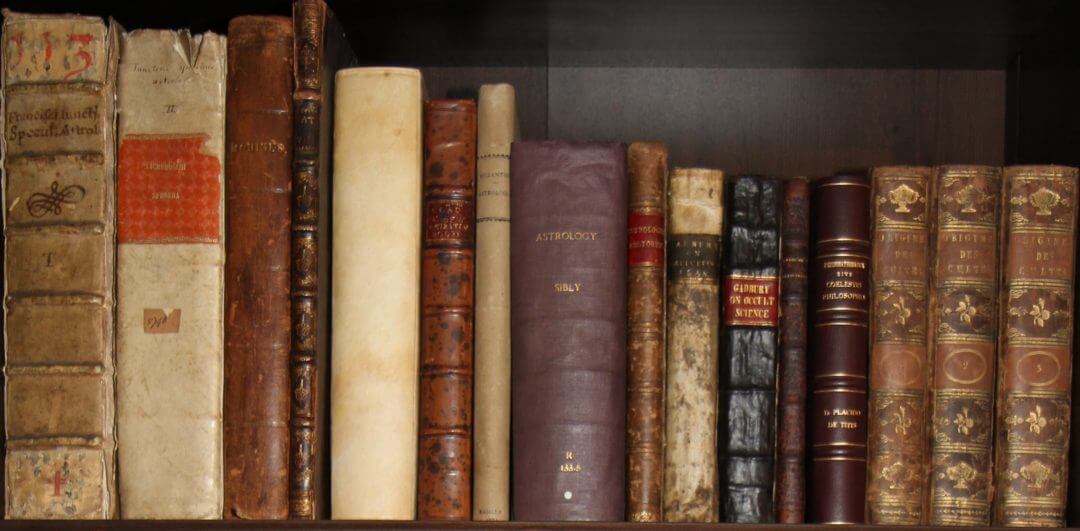Eland, W., Philomat. ‘A Tutor to Astrologie: OR, ASTROLOGY made easie. Being a plain Introduction to the whole Art of Astrology. Whereby the meanest Apprehension may learn to Erect a Figure; and by the same, to give a determinate judgement upon any Question or Nativity whatsover. Also new Tables of Houses, calculated for the Latitude of 51 degrees 32 minutes. Also Tables of Right and Oblique Ascension, to 6 degrees of Latitude. Whereunto is added, An EPHEMERIS For the Year, 1665, 1666, 1667. With all other necessary Tables, that belong to the Art of Astrology. Also how to erect a Figure the rational way, by the Tables of Triangles, more methodically than hath yet been published. – Digested into this Pocket-volumn, for the conveniency of those that erect Figures abroad’ The fifth Edition – Corrected and Enlarged – printed for Joseph Moxon, and sold at his shop on Ludgate-hill near Fleet-bridge, at the Sign of Atlas, London, undated. Former bookplate of James [Hustler][1] of Acklam in Cleveland in the North Riding of the County of York, dated 1730, adhered to front paste-down.
Small-format old full leather (separation to lower extremities of both hinges, and slightly to upper extremities; wear to lower corners of boards; heavy wear to upper outer corners of boards; lower half of front inner hinge weak). (2 cm tear to outer edge of title leaf, crossing text. Smallish worm-holes to upper outer margins of pp. [49]-61, not affecting legibility of text or tables. Large ink blot to pp. 82-3, affecting legibility of some text on p. 82. Outer margin of final page of tables partly abraded, with minimal loss of data.) [1] + [25 pages of tables] + [1] + [24 pages of tables] + [1] + [25 pages of tables] + [pp. 25-91] + [2 pages of tables] + [pp. 94-118] + [45 pages of tables] + [3] + [5 pages of tables]
[1] The latter part of the name is hard to see owing to a fold and slight tear in the bookplate at this point, but has been deduced from Internet resources describing the same bookplate
About this Book Scan
Carefully scanned in full colour from our original printing purchased at auction in the 2010s.
A Tutor to Astrologie by William Eland was a pocket-sized book designed to teach the rudiments of astrology to the student in the 17th century.
The original edition, dated to 1657, appears to have featured ephemerides for only 1657 and 1658. Subsequent editions, when they periodically appeared, would appear chiefly to have updated the coverage of the ephemeris to deal with the year of printing and the two years following it. Thus we believe our edition to date from 1665.
A sixth edition would follow in 1670, with its ephemerides further revised to span the years 1670 to 1672.
Manchester Public Libraries record an edition of 1662, but it is not numbered. It would appear that if there were in fact three editions between the first of 1657 and the fifth of 1665, then they were all printed in very limited numbers, since almost none of them is recorded in libraries. The small physical size format of the book has probably further counted against survivals of all editions into the 21st century.
After Eland’s death, fellow astrologer George Parker overhauled and expanded his book into a longer one retitled Eland’s Tutor to Astrology (note the changed spelling from Astrologie). This was nominally the tenth overall edition and was published in 1704, and seems to be a little more common than the earlier editions today. A scan of our original printing of Parker’s revised edition is also separately available from Astrolearn.
For Eland’s authentic original work, however, the present scan of the fifth edition gives a more reliable account.
NB: Please note that there are some defects to our original printing of this early edition, though all pages are present. In particular, there is some loss to the outer margin of the final leaf of tables, and an ink blot on pages 82-3 obscures some characters of text upon them. The text leaf spanning pp. 55-6 has developed two slight horizontal creases, partly obscuring some characters, but without loss of comprehensibility of the underlying text. These faults notwithstanding, this was the best scan we could attain from the exceedingly scarce source material available.
